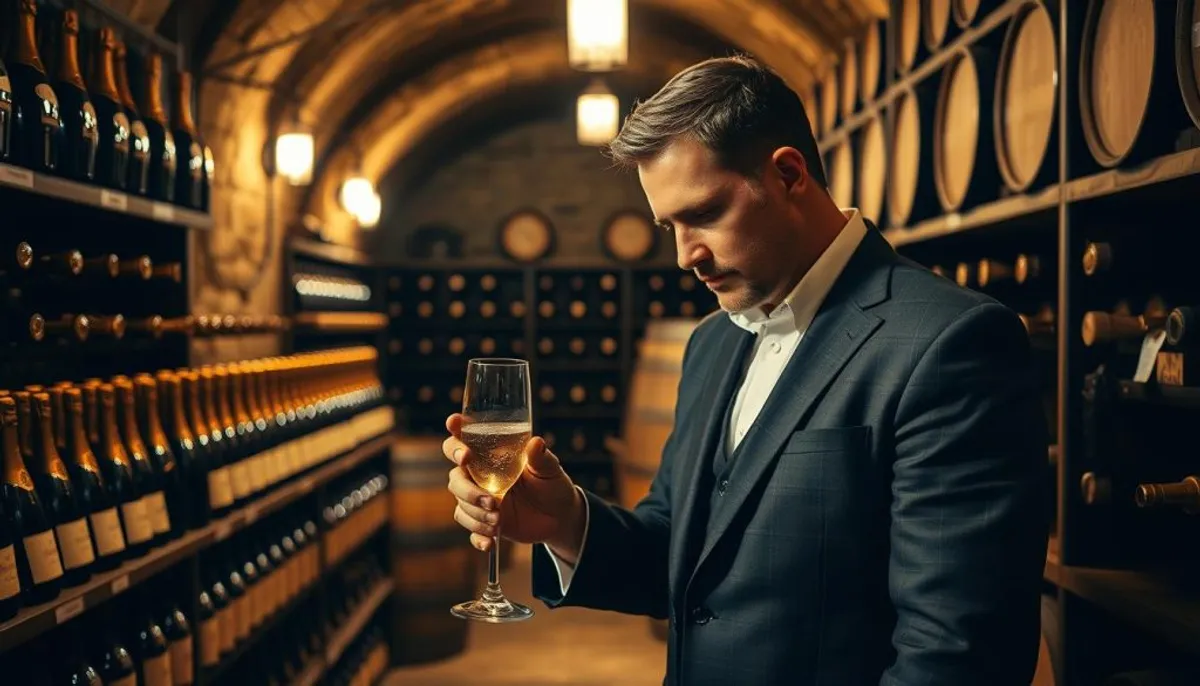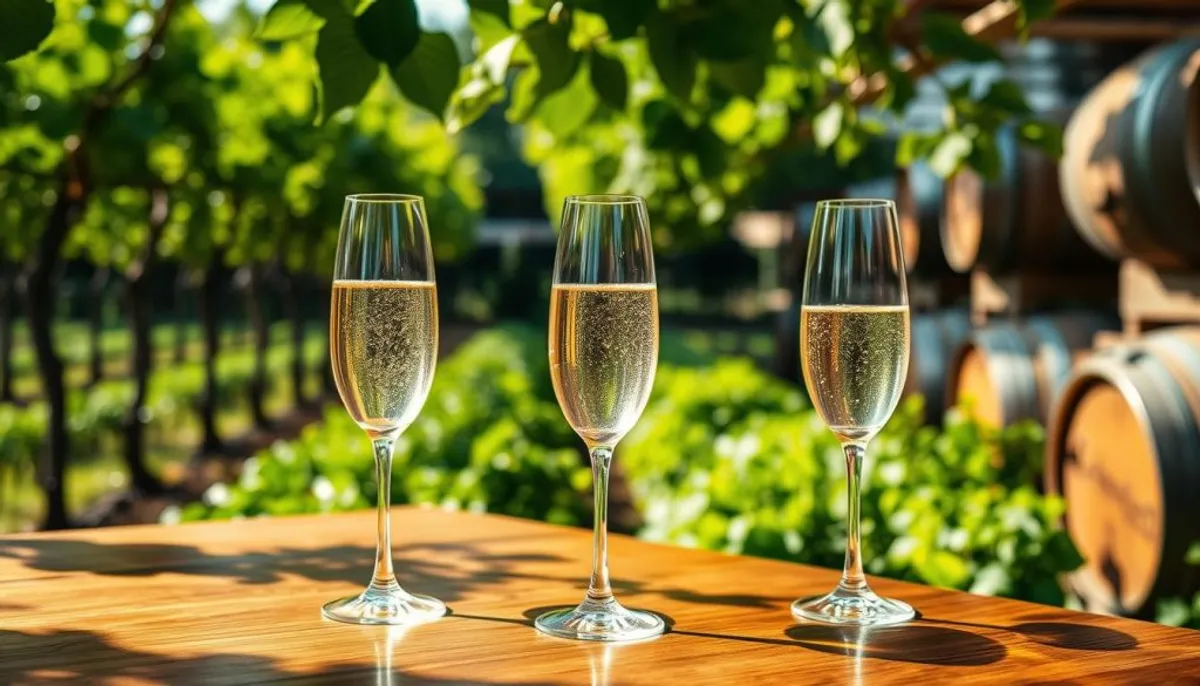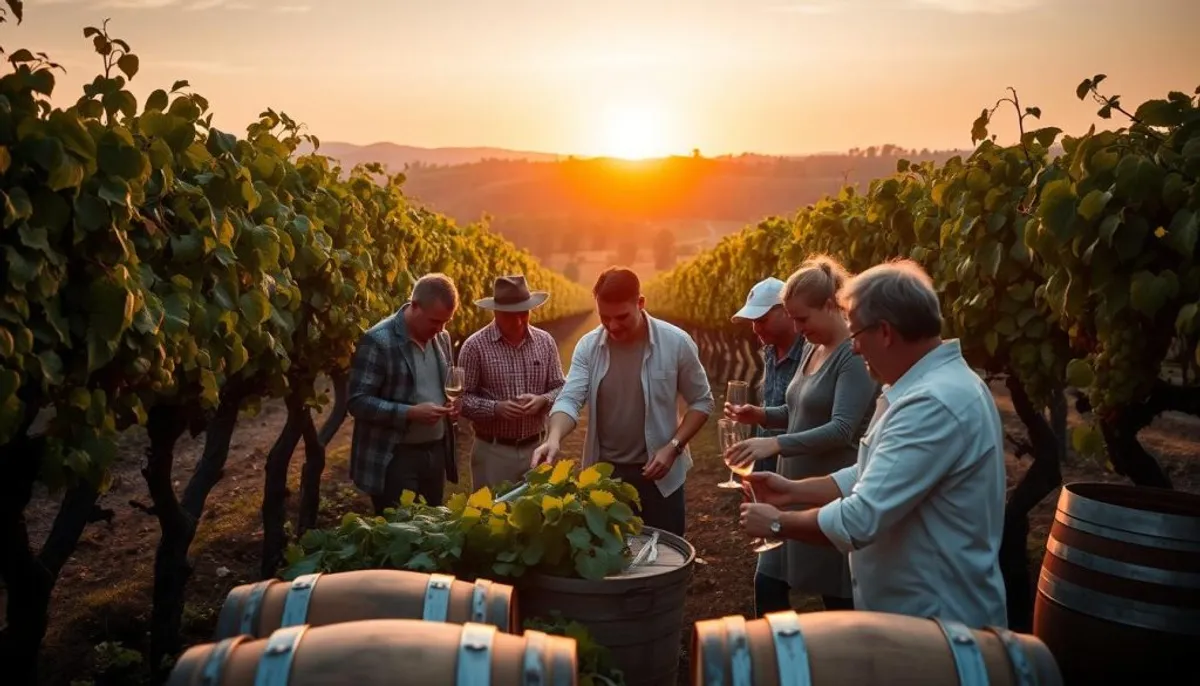In the realm of champagne production, the chef de cave holds a crucial position. This cellar master is the custodian of quality, tradition, and innovation in winemaking. At Veuve Clicquot, a leading champagne house, the chef de cave manages a vast operation. It spans 390 hectares of vineyards.

The chef de cave’s duties are both varied and challenging. During harvest season, they labor from 6 a.m. to 10 p.m. Their focus is on selecting only the finest grapes. Veuve Clicquot produces 2,550 liters of juice per harvest. Of this, 2,050 liters are classified as Cuvée quality.
Quality control is central to the chef de cave’s role. At Veuve Clicquot, Chef de Caves Dominique Demarville leads a team of 12 in daily wine-tasting sessions. This meticulous process is essential for upholding the house’s esteemed standards and unique style.
Key Takeaways
- Chef de cave oversees all aspects of champagne production
- Responsible for quality control from grape selection to final blending
- Leads daily wine-tasting sessions for quality assurance
- Manages vineyard operations and juice extraction
- Ensures consistency in house style and flavor profiles
- Stays connected with global market trends and regulations
The Role of Chef de Cave in Champagne Production
The chef de cave is a cornerstone in champagne production, overseeing every step from grape selection to bottling. This role requires a unique combination of technical knowledge and artistic flair. It is essential to preserve the house style and uphold winemaking traditions.
Guardian of Quality and Tradition
The chef de cave is the quality guardian, ensuring only the finest grapes are selected. They make crucial decisions based on weather and grape ripeness, laying the groundwork for exceptional champagne. Their expertise also extends to fermentation, where they select optimal temperatures and vessels to achieve desired flavors.
Responsibilities Throughout the Year
The chef de cave’s work is ongoing, covering the entire production cycle. They blend still wines to create consistent flavors for various cuvées, manage aging, and determine the perfect disgorgement moment. Their role also includes setting dosage levels, ensuring balance and character in the final champagne.
Importance in House Identity
The chef de cave is vital in shaping and preserving the house identity. They blend current and reserve wines to maintain consistency in the house style across different cuvées. This task demands a deep understanding of the champagne house’s history and traditions, as well as the ability to adapt to changing consumer preferences and market trends.
| Aspect | Chef de Cave’s Role |
|---|---|
| Grape Selection | Ensure only high-quality, perfectly-ripened grapes are used |
| Fermentation | Decide on temperatures and vessels for optimal flavor development |
| Blending | Create consistent flavor profiles for different cuvées |
| Aging | Oversee maturation process and determine readiness for disgorgement |
| Dosage | Set final sugar levels for balance and character |
The Harvest Season: September’s Critical Decisions
September heralds the grape harvest, a critical juncture for the chef de cave. At Veuve Clicquot, this position entails managing 390 hectares of vineyards. This includes 12 of the 17 Grands Crus and 20 of the 44 Premiers Crus. The chef de cave’s acumen in vineyard management is paramount during this phase.
During the harvest, pressing centers extract approximately 2,550 liters of juice from the grapes. Of this, 2,050 liters are classified as premium Cuvée quality, with the remaining categorized as Taille. The chef de cave meticulously evaluates the juice quality, making crucial decisions that influence the entire champagne production process.
Long days, from 6 am to 10 pm, are common as the chef de cave evaluates grape quality across extensive vineyards. This hands-on approach ensures only the finest grapes reach the pressing centers. This sets the stage for exceptional champagne and strawberries.
| Juice Type | Volume (Liters) | Quality |
|---|---|---|
| Cuvée | 2,050 | Premium |
| Taille | 500 | Lower |
The harvest season’s unique weather conditions significantly influence decision-making. For example, in 2006, the harvest produced grapes with an average alcohol level of 10.2 and acidity just below 7 g/liter. Such data is pivotal for the chef de cave in crafting the perfect blend for each year’s champagne.
The Art of Wine Tasting and Quality Control
The chef de cave’s role in wine tasting and quality assessment is pivotal in champagne production. This expert engages in daily sensory analysis, refining their skills to uphold the highest standards. Their dedication is essential for maintaining excellence.
Daily Tasting Sessions
Wine tasting sessions are conducted multiple times a day. The chef de cave’s refined palate guides critical decisions on each wine’s potential. These frequent evaluations ensure consistency and excellence in every bottle.

Evaluating Grape Quality
During harvest, the chef de cave meticulously assesses grape quality. They consider factors like ripeness, acidity, and flavor profiles. This evaluation shapes fermentation approaches and determines each batch’s suitability for different cuvées.
Making Critical Blend Decisions
Blend creation is a complex art. The chef de cave may use up to 50 base wines from 6 to 10 vintages to craft the perfect champagne. This intricate process balances current wines with reserve stocks, maintaining the house’s signature style.
| Aspect | Details |
|---|---|
| Base Wines Used | Up to 50 |
| Vintages Blended | 6 to 10 |
| Minimum Aging (e.g., Veuve Clicquot) | 3 years |
The chef de cave’s expertise in wine tasting, sensory analysis, and quality assessment is crucial. Their skill in blend creation ensures each champagne embodies the house’s legacy while meeting the highest quality standards.
Managing the Fermentation Process
The Chef de Cave is pivotal in the champagne fermentation process. This role demands a deep understanding of technical aspects and a keen eye for detail. The goal is to achieve the perfect balance of flavor and alcohol content.
Primary fermentation marks the beginning, where grape juice is converted into wine. The Chef de Cave meticulously controls the temperature, aiming for 16-20°C. This phase, lasting 7-10 days, transforms the grape juice’s natural sugars into alcohol.
Secondary fermentation, happening in the bottle, is what creates champagne’s distinctive bubbles. The selection of specific yeasts during this stage is crucial for the wine’s character. Effective yeast management is key to preventing unwanted flavors and ensuring consistency.
Temperature control is paramount throughout fermentation. The Chef de Cave continuously monitors and adjusts conditions to achieve optimal results. This careful management helps preserve the unique characteristics of each grape variety in the blend. Additionally, personalized champagne labels can enhance the overall presentation of the final product, making it even more special for consumers.
- Chardonnay, Pinot Noir, and Pinot Meunier are the primary grapes used in champagne production
- The cuvée, the highest-quality juice, yields about 2,050 liters per 4,000 kilos of grapes
- Non-vintage champagnes must age for at least 15 months before shipping, with 12 months spent sur lies
Through expertise in fermentation management, the Chef de Cave ensures each champagne bottle meets the high standards of quality and taste. This dedication is what makes champagne a favorite among wine connoisseurs, particularly in the champagne området.
The Crucial Task of Assemblage
Assemblage is a fundamental aspect of champagne production. It involves the meticulous blending of wines to achieve the ideal cuvée. The Chef de Cave’s expertise is essential in combining current vintages with reserve wines. This ensures a consistent house style is maintained.
Blending Current and Reserve Wines
The art of assemblage demands a refined palate and extensive knowledge of the house’s wine library. Chefs de Cave meticulously blend up to 50 different crus. This process balances the unique characteristics of each wine. Chardonnay, which covers 30% of Champagne’s vineyards, contributes freshness. Pinot Noir, making up 38%, adds body and red fruit notes. Pinot Meunier, grown on 31% of the land, brings roundness and intensity.
Creating House Style Consistency
Consistency in the house style is paramount. Reserve wines are crucial in balancing yearly variations. The blending process can take weeks or months, involving dozens of wines. This meticulous approach ensures each bottle embodies the unique identity of the champagne house.
Managing Different Cuvées
Cuvée creation encompasses various champagne styles. Blanc de Blancs, made from 100% Chardonnay, offers crisp elegance. Rosé blends combine Chardonnay and Pinot Noir for a delicate pink hue. Some houses, like Maison De Lozey, use Pinot Blanc instead of Pinot Meunier, showcasing innovation in traditional methods.
| Grape Variety | Vineyard Coverage | Flavor Profile |
|---|---|---|
| Chardonnay | 30% | Freshness, citrus notes |
| Pinot Noir | 38% | Body, red fruit aromas |
| Pinot Meunier | 31% | Roundness, raspberry, green apple |
Aging and Maturation Oversight
The chef de cave is pivotal in the aging of champagne. This expert oversees the maturation of champagne, ensuring each bottle reaches its peak potential. The task requires a deep understanding of cellar management and the intricacies of the maturation process.
Monitoring Cellar Conditions
Cellar conditions are crucial for proper wine aging. The chef de cave monitors temperature, humidity, and light levels. These factors significantly influence how champagne develops over time. Careful cellar management prevents spoilage and promotes the desired flavor profile.
Determining Aging Duration
The aging duration varies for different champagnes. For instance, Dom Pérignon releases its first Plénitude after 8 to 9 years in cellars. The second Plénitude comes after 16 years, and the third after 20 years or more. The chef de cave decides when each cuvée is ready for disgorgement, marking the end of the maturation process.
| Plénitude | Aging Duration | Characteristics |
|---|---|---|
| P1 (First) | 8-9 years | Fresh, vibrant |
| P2 (Second) | 16 years | Complex, mature |
| P3 (Third) | 20+ years | Rich, intense |
The chef de cave’s expertise in wine aging and cellar management ensures each bottle of champagne reaches its full potential. This meticulous oversight of the maturation process results in the exceptional quality and distinct character that champagne enthusiasts worldwide have come to expect.
Market Analysis and Global Representation
The role of the chef de cave transcends the vineyards. These experts are pivotal in analyzing champagne market trends and representing their brands globally. They must stay informed about the dynamic global wine industry, including emerging sectors like the rwandan wine market.
Recent years have brought significant changes to the champagne market. The USA saw a 2.7% increase in imports, reaching 23.7 million bottles in 2018. Japan’s imports rose by 5.5%, totaling 13.6 million bottles. The Chinese market, including Hong Kong and Taiwan, experienced a 9.1% growth, with 4.7 million bottles purchased.
Brand representation is a key focus for chefs de cave, who frequently travel, often for one to two weeks monthly. They interact with distributors, sommeliers, and consumers to ensure their house’s global visibility. This hands-on approach enables them to adapt to evolving consumer tastes and regulatory changes across markets.
The global turnover for Champagne reached nearly €4.9 billion in 2018, underscoring the industry’s economic significance. To remain competitive, many houses are innovating. Louis Roederer and Piper-Heidsieck have introduced limited edition, expensive bottles. Perrier-Jouët and Ruinart are focusing on lucrative prestige cuvées.
Chefs de cave must navigate these market dynamics while safeguarding their house’s unique identity. Their dual expertise in winemaking and market analysis makes them indispensable in the competitive global wine industry.
Technical Expertise and Innovation
The role of Chef de Cave necessitates profound knowledge in oenology and viticulture. These connoisseurs merge scientific principles with artistic flair to produce unparalleled champagnes. They must navigate the intersection of innovation and tradition, ensuring their creations remain both forward-thinking and rooted in heritage.
Scientific Knowledge Requirements
A Chef de Cave must possess a comprehensive grasp of grape varieties, fermentation methodologies, and flavor nuances. Their oenological acumen enables them to craft distinctive blends that embody the house’s essence. Concurrently, their viticultural expertise ensures the cultivation of grapes of superior quality, directly influencing the final product’s excellence.
Adaptation to Climate Changes
Climate adaptation has become a pressing issue for Champagne producers, particularly in the champagne området. Chefs de Cave must adapt their practices to uphold quality standards amidst fluctuating environmental conditions. This may involve adjusting harvest schedules or introducing grape varieties more resilient to warmer climates.
Modern Winemaking Technologies
Adopting cutting-edge winemaking technologies is imperative for maintaining competitiveness. Chefs de Cave frequently integrate novel technologies to refine production efficiency and quality. This might encompass the utilization of precision viticulture tools or advanced fermentation monitoring systems. Yet, they must ensure these innovations do not compromise the champagne’s traditional essence and quality benchmarks.
| Aspect | Traditional Method | Modern Innovation |
|---|---|---|
| Fermentation Monitoring | Manual checks | Digital sensors |
| Grape Selection | Visual inspection | Optical sorting technology |
| Climate Control | Natural cellar conditions | Precision temperature regulation |
Leadership and Team Management

The Chef de Cave is pivotal in leading the winemaking team at champagne houses. This role demands outstanding leadership abilities to cultivate a collaborative atmosphere. It also necessitates guiding the team towards the creation of exceptional champagne.
Mentorship is at the core of their duties. The Chef de Cave imparts their profound knowledge to junior team members. This ensures the continuation of the house’s traditions and the preservation of champagne quality and consistency.
Collaborative winemaking is central to the Chef de Cave’s methodology. They promote input from every team member, valuing varied viewpoints and experiences. This approach fosters innovative solutions and enhances the champagne-making process.
| Aspect | Role of Chef de Cave |
|---|---|
| Team Leadership | Guide winemaking team, foster collaboration |
| Mentorship | Share expertise, ensure knowledge transfer |
| Decision Making | Balance individual expertise with team synergy |
| Innovation | Encourage new ideas, refine processes |
The Chef de Cave must harmonize individual expertise with team cohesion. They make pivotal decisions, taking into account the collective input of the winemaking team. This method ensures that the final product embodies the collective wisdom and capabilities of the team.
Preserving House Legacy and Tradition
Champagne houses are repositories of ancient winemaking traditions. The Chef de Cave is pivotal in safeguarding these legacies, ensuring a seamless continuation of style. Their profound understanding of champagne history empowers them to respect the past while guiding the future.
Historical Knowledge
The Chef de Cave must possess an intimate grasp of their house’s narrative. Veuve Clicquot, established in 1772, exemplifies this. Under the stewardship of Didier Mariotti, the 11th custodian, the house continues to evolve. Mariotti’s tenure is a testament to Madame Clicquot’s pioneering spirit, who introduced the world’s first rosé d’assemblage in 1818.
Maintaining House Style
In champagne production, consistency is paramount. The Chef de Cave ensures each bottle embodies the distinct essence of their house. At Veuve Clicquot, this commitment is evident in their flagship cuvée, La Grande Dame. Now boasting 90% Pinot Noir, it underscores their dedication to this grape variety. For those interested in understanding the market, a veuve clicquot preis guide can provide valuable insights into pricing and availability.
| Champagne House | Founded | Current Chef de Cave | Signature Style |
|---|---|---|---|
| Veuve Clicquot | 1772 | Didier Mariotti | Pinot Noir-dominant blends |
| Moët & Chandon | 1743 | Benoît Gouez | Balanced, fruit-forward wines |
Chefs de Cave, such as Mariotti and Gouez, navigate the delicate balance between tradition and innovation. Their efforts ensure their houses remain vanguards in champagne production, safeguarding their legacies for generations to come.
Conclusion
The chef de cave role represents the zenith of champagne mastery. These custodians of quality merge artistic flair with scientific acumen. They shape the essence of renowned champagne houses and are increasingly aware of the emerging english wine regions. Their expertise is pivotal at every stage of luxury wine production, from the initial harvest to the final blend.
Richard Geoffroy’s 28-year tenure as Dom Pérignon’s chef de cave exemplifies the dedication required. His shift to sake production highlights the versatility of winemaking skills. The chef de cave must navigate evolving consumer preferences and climate shifts while upholding ancient traditions.
In summary, the chef de cave is the cornerstone of champagne’s allure. Their position necessitates ongoing learning, innovation, and an unwavering passion for their craft. As they navigate each vintage, these masters ensure every bottle embodies the pinnacle of luxury wine production. They continue to enthrall wine aficionados globally.
RelatedRelated articles



